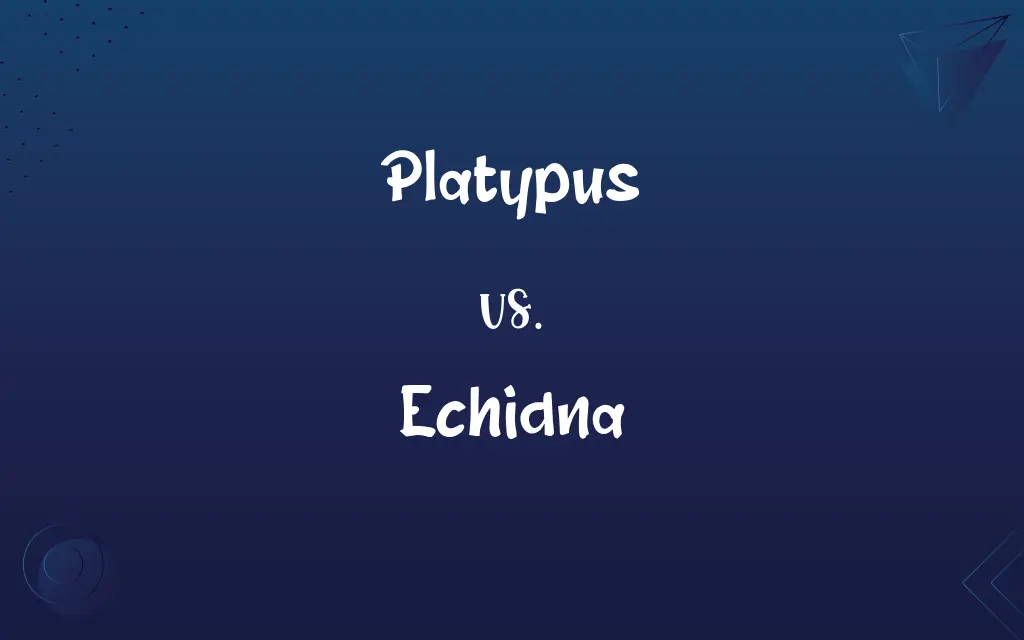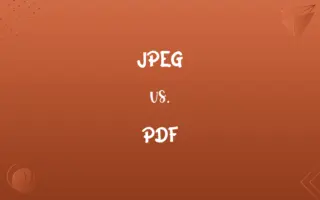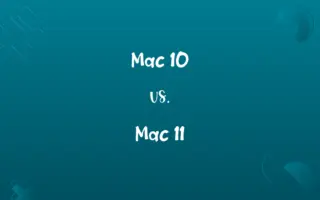Platypus vs. Echidna: Know the Difference

By Shumaila Saeed || Published on February 6, 2024
Platypus and echidna are both egg-laying mammals, with the platypus being aquatic and echidna terrestrial, featuring a duck-bill and spines, respectively.

Key Differences
The platypus, known for its distinctive duck-billed appearance, is an aquatic creature, adept in swimming. The echidna, on the other hand, is known for its spiky coat and terrestrial habitat. Both are monotremes, a rare group of egg-laying mammals, sharing this unique reproductive feature.
Shumaila Saeed
Feb 06, 2024
Platypuses are primarily found in eastern Australia, thriving in rivers and freshwater environments. Echidnas, although also native to Australia, are more widespread and adaptable to various environments, including deserts and forests. Both animals exhibit a remarkable adaptation to their respective habitats, demonstrating the diversity of monotremes.
Shumaila Saeed
Feb 06, 2024
Dietary habits of the platypus include consuming aquatic invertebrates, thanks to its sensitive bill. Echidnas, conversely, use their long, sticky tongues to feed on ants and termites. This difference in diet underscores the distinct ecological niches occupied by both the platypus and echidna.
Shumaila Saeed
Feb 06, 2024
The reproductive process of the platypus involves laying eggs in burrows near water bodies, whereas echidnas lay eggs in a pouch on their bodies. Despite these differences, both species incubate their eggs outside the mother's body, a unique trait among mammals.
Shumaila Saeed
Feb 06, 2024
Platypuses are known for their electrolocation ability, using their bills to detect prey underwater. Echidnas lack this capability but compensate with a keen sense of smell and hearing. Both species showcase unique evolutionary adaptations, making them fascinating subjects of study in the animal kingdom.
Shumaila Saeed
Feb 06, 2024
ADVERTISEMENT
Comparison Chart
Sensory Adaptations
Electrolocation in water
Keen sense of smell and hearing
Shumaila Saeed
Feb 06, 2024
ADVERTISEMENT
Geographical Location
Primarily eastern Australia
Widespread across Australia
Shumaila Saeed
Feb 06, 2024
Conservation
Sensitive to environmental changes
More resilient to environmental shifts
Shumaila Saeed
Feb 06, 2024
ADVERTISEMENT
Platypus and Echidna Definitions
Platypus
An animal with a waterproof, fur-covered body, adapted to its aquatic lifestyle.
The platypus's fur kept it insulated in the cold river waters.
Shumaila Saeed
Jan 12, 2024
Echidna
A spiny, terrestrial mammal, known for its egg-laying capability and ant-eating habits.
The echidna foraged in the forest floor, hunting for ants with its long tongue.
Shumaila Saeed
Jan 12, 2024
Platypus
A unique mammal known for its electroreception and webbed feet.
The platypus detected its prey underwater through electroreception.
Shumaila Saeed
Jan 12, 2024
Echidna
An inhabitant of various Australian environments, with a distinctive coat of spines.
The echidna's spines provided protection against predators in the wild.
Shumaila Saeed
Jan 12, 2024
Platypus
An aquatic, egg-laying mammal, native to eastern Australia, with a distinctive duck-like bill.
The platypus swam gracefully, using its bill to navigate the murky riverbed.
Shumaila Saeed
Jan 12, 2024
Echidna
A creature capable of rolling into a ball for defense, using its spines.
When threatened, the echidna curled into a ball, its spines deterring the predator.
Shumaila Saeed
Jan 12, 2024
Platypus
A representative of monotremes, laying eggs instead of giving live birth.
Researchers were fascinated by the platypus's egg-laying process, a rare trait in mammals.
Shumaila Saeed
Jan 12, 2024
Echidna
An animal with strong, digging claws and a keen sense of smell.
The echidna used its claws to dig into the soil, searching for food.
Shumaila Saeed
Jan 12, 2024
Platypus
A species with a flat, beaver-like tail and otter-like body.
The platypus used its flat tail to steer through the water efficiently.
Shumaila Saeed
Jan 12, 2024
Echidna
A monotreme with a specialized snout and sticky tongue for feeding.
The echidna's sticky tongue was perfect for capturing termites in tight spaces.
Shumaila Saeed
Jan 12, 2024
Platypus
A semiaquatic egg-laying mammal (Ornithorhynchus anatinus) of eastern Australia and Tasmania, having a broad flat tail, webbed feet, a snout resembling a duck's bill, and in the male, venomous spurs on the hind legs. Also called duckbill, duck-billed platypus.
Shumaila Saeed
Jan 10, 2024
Echidna
Any of several nocturnal burrowing egg-laying mammals of the genera Tachyglossus and Zaglossus of Australia, Tasmania, and New Guinea, having a spiny coat, a slender snout, and an extensible sticky tongue used for catching insects.Also called spiny anteater.
Shumaila Saeed
Jan 10, 2024
Platypus
A semi-aquatic, egg-laying monotreme mammal with a bill resembling that of a duck, that has a mole-like body, a tail resembling that of a beaver, a waterproof pelt, and flat webbed feet — males have poisonous spurs on the inside of the back legs; Ornithorhynchus anatinus
Shumaila Saeed
Jan 10, 2024
Echidna
Any of the species of small spined monotremes in family Tachyglossidae, the four extant species of which are found in Australia and southern New Guinea.
Shumaila Saeed
Jan 10, 2024
Platypus
Small densely furred aquatic monotreme of Australia and Tasmania having a broad bill and tail and webbed feet; only species in the family Ornithorhynchidae
Shumaila Saeed
Jan 10, 2024
Echidna
A genus of Monotremata found in Australia, Tasmania, and New Guinea. They are toothless and covered with spines; - called also porcupine ant-eater, and Australian ant-eater.
Shumaila Saeed
Jan 10, 2024
Echidna
Burrowing spine-covered monotreme of Australia having a long snout and claws for hunting ants and termites
Shumaila Saeed
Jan 10, 2024
Repeatedly Asked Queries
Can echidnas swim?
Echidnas can swim but are primarily terrestrial animals.
Shumaila Saeed
Feb 06, 2024
What do platypuses eat?
Platypuses primarily eat aquatic invertebrates like insects and larvae.
Shumaila Saeed
Feb 06, 2024
Do echidnas lay eggs?
Yes, echidnas are one of the few mammals that lay eggs.
Shumaila Saeed
Feb 06, 2024
Can platypuses be kept as pets?
No, platypuses are wild animals and not suitable for domestication.
Shumaila Saeed
Feb 06, 2024
Are platypuses venomous?
Yes, male platypuses have venomous spurs on their hind legs.
Shumaila Saeed
Feb 06, 2024
Are echidnas social animals?
Echidnas are generally solitary, except during breeding season.
Shumaila Saeed
Feb 06, 2024
How do echidnas protect themselves?
Echidnas use their spines as a defense mechanism against predators.
Shumaila Saeed
Feb 06, 2024
Do platypuses have teeth?
Adult platypuses do not have teeth; they grind food using ridges in their bills.
Shumaila Saeed
Feb 06, 2024
What is unique about the platypus bill?
The platypus bill is highly sensitive and used for electrolocation.
Shumaila Saeed
Feb 06, 2024
How long do platypuses live?
Platypuses can live up to 17 years in the wild.
Shumaila Saeed
Feb 06, 2024
Are platypuses endangered?
Platypuses are not currently endangered but face threats from habitat loss.
Shumaila Saeed
Feb 06, 2024
How do platypuses care for their young?
Platypus mothers nurse their young in burrows for several months.
Shumaila Saeed
Feb 06, 2024
What is the echidna's primary habitat?
Echidnas inhabit various environments, from forests to deserts.
Shumaila Saeed
Feb 06, 2024
How do echidnas feed their young?
Echidna mothers feed their young with milk secreted from mammary glands.
Shumaila Saeed
Feb 06, 2024
How fast can an echidna run?
Echidnas are not fast runners; they rely on their spines for protection.
Shumaila Saeed
Feb 06, 2024
Do platypuses hibernate?
Platypuses do not hibernate but may be less active in cold weather.
Shumaila Saeed
Feb 06, 2024
Are echidnas good climbers?
Echidnas can climb, using their strong claws to grip.
Shumaila Saeed
Feb 06, 2024
What threats do echidnas face?
Echidnas face threats from habitat loss and predators like foxes and dogs.
Shumaila Saeed
Feb 06, 2024
How do echidnas communicate?
Echidnas communicate through scent markings and vocalizations.
Shumaila Saeed
Feb 06, 2024
What is the breeding season for platypuses?
Platypuses usually breed between June and October.
Shumaila Saeed
Feb 06, 2024
Share this page
Link for your blog / website
HTML
Link to share via messenger
About Author
Written by
Shumaila SaeedShumaila Saeed, an expert content creator with 6 years of experience, specializes in distilling complex topics into easily digestible comparisons, shining a light on the nuances that both inform and educate readers with clarity and accuracy.








































































